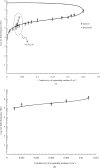Dielectrophoretic spectra of translational velocity and critical frequency for a spheroid in traveling electric field
- PMID: 20644671
- PMCID: PMC2905268
- DOI: 10.1063/1.3294082
Dielectrophoretic spectra of translational velocity and critical frequency for a spheroid in traveling electric field
Abstract
An analysis has been made of the dielectrophoretic (DEP) forces acting on a spheroidal particle in a traveling alternating electric field. The traveling field can be generated by application of alternating current signals to an octapair electrode array arranged in phase quadrature sequence. The frequency dependent force can be resolved into two orthogonal forces that are determined by the real and the imaginary parts of the Clausius-Mossotti factor. The former is determined by the gradient in the electric field and directs the particle either toward or away from the tip of the electrodes in the electrode array. The force determined by the imaginary component is in a direction along the track of the octapair interdigitated electrode array. The DEP forces are related to the dielectric properties of the particle. Experiments were conducted to determine the DEP forces in such an electrode arrangement using yeast cells (Saccharomyces cervisiate TISTR 5088) with media of various conductivities. Experimental data are presented for both viable and nonviable cells. The dielectric properties so obtained were similar to those previously reported in literature using other DEP techniques.
Figures






Similar articles
-
Continuous Cell Characterization and Separation by Microfluidic Alternating Current Dielectrophoresis.Anal Chem. 2019 May 7;91(9):6304-6314. doi: 10.1021/acs.analchem.9b01104. Epub 2019 Apr 22. Anal Chem. 2019. PMID: 30977369
-
Electric field-induced effects on neuronal cell biology accompanying dielectrophoretic trapping.Adv Anat Embryol Cell Biol. 2003;173:III-IX, 1-77. doi: 10.1007/978-3-642-55469-8. Adv Anat Embryol Cell Biol. 2003. PMID: 12901336 Review.
-
Analytical solutions of ac electrokinetics in interdigitated electrode arrays: electric field, dielectrophoretic and traveling-wave dielectrophoretic forces.Phys Rev E Stat Nonlin Soft Matter Phys. 2007 Oct;76(4 Pt 2):046610. doi: 10.1103/PhysRevE.76.046610. Epub 2007 Oct 25. Phys Rev E Stat Nonlin Soft Matter Phys. 2007. PMID: 17995130
-
Analysis of the dielectrophoretic properties of cells using the isomotive AC electric field.Biomicrofluidics. 2018 Jul 6;12(4):044103. doi: 10.1063/1.5031054. eCollection 2018 Jul. Biomicrofluidics. 2018. PMID: 30034566 Free PMC article.
-
Dielectrophoretic separation of bioparticles in microdevices: a review.Electrophoresis. 2014 Mar;35(5):691-713. doi: 10.1002/elps.201300424. Epub 2014 Feb 4. Electrophoresis. 2014. PMID: 24338825 Review.
Cited by
-
Label-free isolation of circulating tumor cells in microfluidic devices: Current research and perspectives.Biomicrofluidics. 2013 Jan 24;7(1):11810. doi: 10.1063/1.4780062. eCollection 2013. Biomicrofluidics. 2013. PMID: 24403992 Free PMC article.
-
Modeling of dielectrophoretic transport of myoglobin molecules in microchannels.Biomicrofluidics. 2010 Mar 1;4(1):14105. doi: 10.1063/1.3339773. Biomicrofluidics. 2010. PMID: 20644674 Free PMC article.
-
A Prominent Cell Manipulation Technique in BioMEMS: Dielectrophoresis.Micromachines (Basel). 2020 Nov 3;11(11):990. doi: 10.3390/mi11110990. Micromachines (Basel). 2020. PMID: 33153069 Free PMC article. Review.
-
Using dielectrophoretic spectra to identify and separate viable yeast cells.Appl Microbiol Biotechnol. 2023 Dec;107(24):7647-7655. doi: 10.1007/s00253-023-12809-5. Epub 2023 Oct 10. Appl Microbiol Biotechnol. 2023. PMID: 37815615
References
-
- Talary M. S., Burt J. P. H., Tame J. A., and Pethig R., J. Phys. D: Appl. Phys. JPAPBE 29, 2198 (1996).10.1088/0022-3727/29/8/021 - DOI
-
- Hughes M. P., Nanotechnology NNOTER 11, 124 (2000).10.1088/0957-4484/11/2/314 - DOI
-
- Fuhr G., Hagedorn R., Muller T., Benecke W., Wagner B., and Gimsa J., Stud. Biophys. STBIBN 140, 79 (1991).
LinkOut - more resources
Full Text Sources
Molecular Biology Databases
